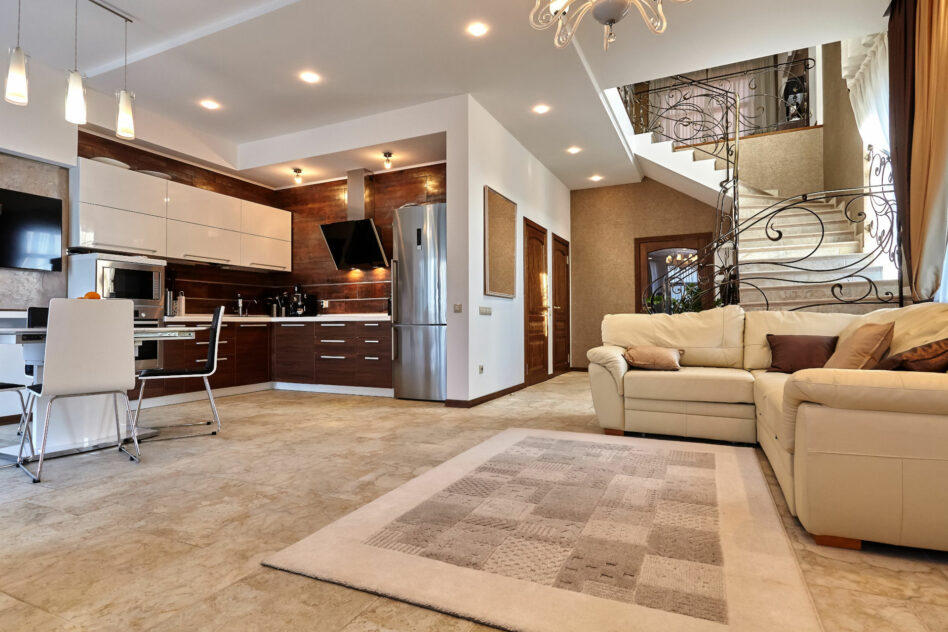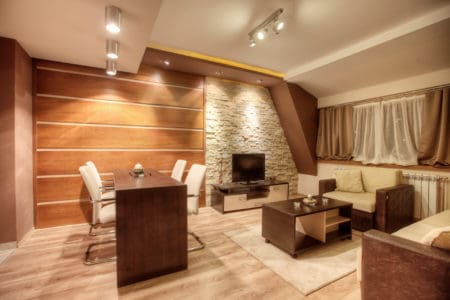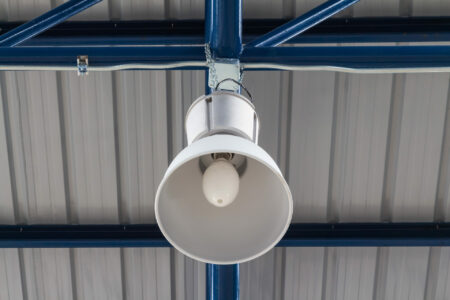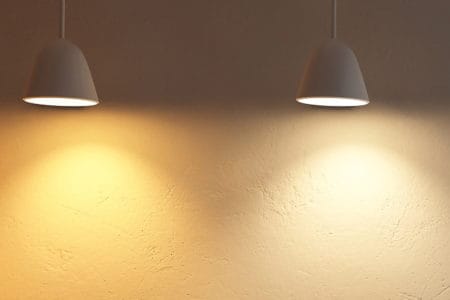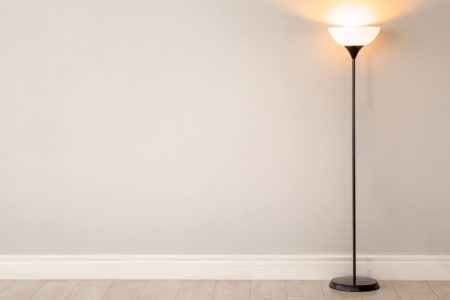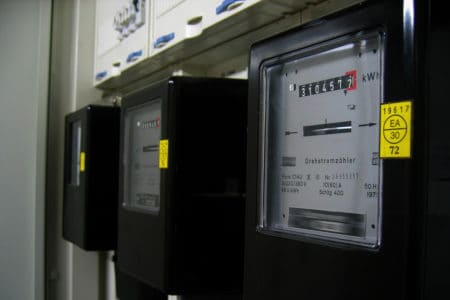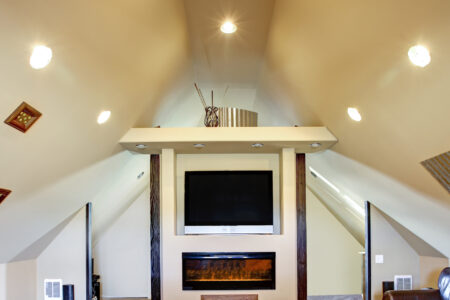Recessed lights are many interior decorators’ dreams. Indeed, some rooms benefit significantly from large central light fixtures, but a more toned-down approach can be just as valuable. Recessed lights can help you accomplish much with a room, especially if there’s limited space available.
But which type should you go for? Let’s look at the different types of recessed lighting.
The types of recessed lighting can be sorted into three categories: housing, trim, and lamps. The varieties under each category can be mixed and matched with types under the other categories to create a nearly limitless number of unique recessed lighting types for every room in your home.
Types Of Recessed Light Housings
The first category is the housing of a recessed light. Before we look at the different housing options, let’s discuss what housing is in this context.
You could describe the housing as the primary component of the recessed lighting unit. The housing is installed inside the ceiling or roof, and the idea is that it should not be visible inside the room. It connects the light to electricity and holds the lamp (and often the trim) in place.
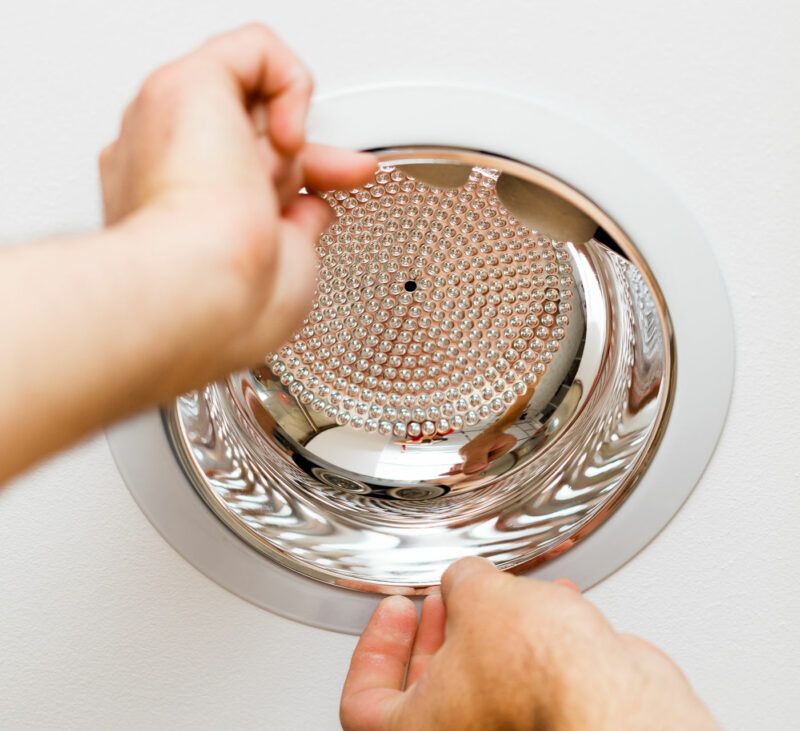
There are two types of recessed light housing: those for new constructions and remodels. You can also find different variations of each. For example, some only hold one lamp, while others have two or three. Some housings are custom-made for sloped or curved ceilings, while most are only for flat ceilings.
It’s also worth mentioning that recessed lights in spaces other than your ceiling have basically the same housing types.
1. New Installation Recessed Light Housings
As the name suggests, new installation recessed light housings are designed to be used in new buildings. When planning your home, you can make the roof and ceiling whatever you want, so you can plan for new installation housings.
Recessed light housings for new installations are designed to fit against the support structures, like joist beams or mounting frames. Hence you can tighten them quite a lot, ensuring a sturdy fitting for your lights.
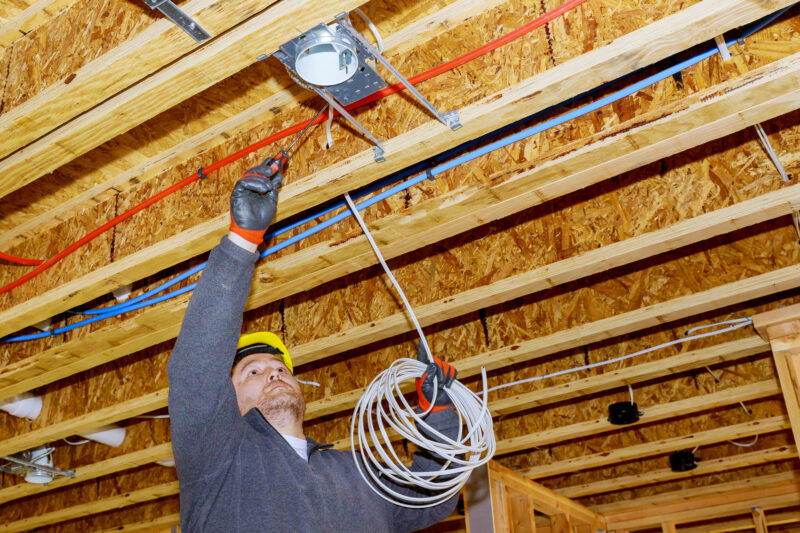
The downside with new installation housings, and the reason why remodel housings exist, is that you need plenty of space and solid mounting structures to install the fitting. That’s why it’s essential to prepare for your recessed lights while you’re planning the building so that you can ensure enough ceiling space for recessed light housings.
2. Recessed Light Housings For Remodels
Remodel housings for recessed lights are designed to be used when you remodel your home or building. They differ from new installation housings in a few small but significant ways because of their ideal use scenario.
When you remodel an existing home or building, you can’t plan for recessed lights during construction, so you don’t always have adequate space or support structures available in the ceiling to install the fittings. Some have small crawlspaces rather than ceilings, and there may not be joist beams in the right places.
New installation recessed light housings would not be appropriate in these cases since they might be too big and need adequate ceiling access to fasten them to support beams.
A remodel light housing differs in two ways:
- It’s usually smaller and easier to fit through a hole in the ceiling rather than installing it from the top.
- These housings use the ceiling for support rather than joist beams, so they usually have spring clips that hold them in place above the ceiling.
Remodel housings have some disadvantages over new installation housings:
- They aren’t as sturdy or strong as new installation housings, and applying too much force will pull them from the ceiling. This is not usually a problem, but it’s essential to know.
- The original light fittings’ wiring probably wasn’t appropriate for recessed lights. To prevent any issues always work together with a qualified electrician before starting the remodeling project.
But despite these disadvantages, if you don’t have adequate ceiling space or your ceiling is inadequate for new installation housings in some other way, using remodel housings is your only option for recessed lights.
Recessed Lighting Lamp Types
The technology of the lamps or light bulbs we use in recessed lighting is mostly the same as those in any other light fittings, with the primary differences being their size and shape.
Most of the world has moved on from standard incandescent light bulbs. Even energy-saving CFL (compact fluorescent) light bulbs are fading away and being replaced with more energy-efficient, cheaper, and more powerful LED lamps. Thus, LED light bulbs are the most common type used in modern recessed lighting installations.
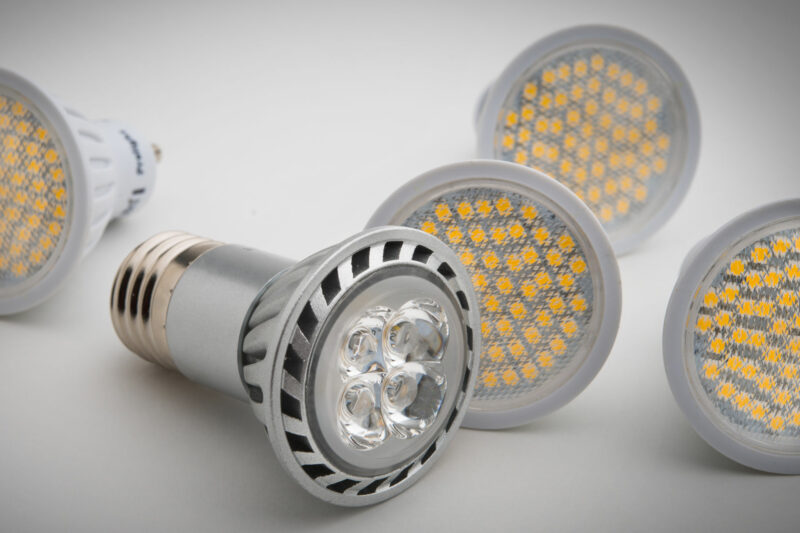
Regardless of the technology, the critical focus for the types of recessed lighting light bulbs is the shape since that also affects the aesthetics and potency of the light.
3. Reflector (R) Bulbs In Recessed Lighting
Reflector bulbs, and some variations on the basic shape, have become the de facto standard in recessed lighting. They are the ones most commonly found. These bulbs have a slight curve in the front where the light shines out of the housing, and the curve helps spread the light around the room rather than focusing it in one spot.
The inside of the light bulb is coated with a reflective surface to ensure that as much of the light as possible will be reflected down into the room rather than have some of it bounce up into the housing, becoming wasted light.
This means better energy efficiency since you can use fewer lights to achieve the same brightness, which is one of the reasons why recessed lighting is so popular.
4. Bulged Reflector Light Bulbs (BR)
Bulged reflector lamps are the most prevalent variation on standard reflector bulbs, with only one significant difference: these light bulbs have a bulge between the light source and the connector. The light bulb still has a slightly curved front, so it’s also effective at diffusing the light over a reasonably wide area.
However, the bulge helps to reflect even more light through the front, leading to even less wasted light. Though the gains aren’t massive, there is a slight improvement in the brightness of a bulged reflector over a standard reflector lamp.
5. Parabolic Aluminized Reflector Light Bulbs (PAR)
Parabolic aluminized reflector lamps have a strongly reflective surface made of aluminum. You can easily spot the difference between these and other reflector bulbs because these have a shiny metallic shell instead of the white plastic shell that the others have.
Another difference is that the PAR bulb has a parabolic reflector shape, which helps to reflect the light in a tightly focused beam, similar to a stage spotlight. The face of the light bulb has less of a curve than the R and BR lamps, which also helps to focus the light more directly.
With these differences in mind, parabolic aluminized lamps are ideal if you have recessed lights that need to place emphasis on something. For example, a painting, family portrait, or sculpture can be accentuated in a room if you strategically place recessed lights with PAR light bulbs around it.
6. Multifaceted Reflector (MR) Light Bulbs
You will find multifaceted reflector lights in more places than parabolic aluminized reflectors because they are even better at creating a spotlight effect than PAR light bulbs. You can identify them by the many metallic reflective squares layering the inside of the lamp. These reflectors help to focus the light into a densely concentrated beam.
Even though they are slightly more expensive than PAR light bulbs, MRs are generally a better choice if you want to emphasize a particular item or spot in a room with recessed lights. The more focused beam can accentuate edges and corners, so keep that in mind. PAR light bulbs will create a slightly softer emphasis than MR lamps.
7. Omnidirectional Light Bulbs
Omnidirectional recessed lighting lamps adapt older light bulb types so you can use them in recessed lights. They come in various forms, including type A (Arbitrary), Twist, Spiral, and Tube.
The type A omnidirectional light bulb is based on the typical light bulbs you would find in traditional light fittings (though they can also use LEDs and are not necessarily incandescent).
Twist, tube, and spiral light bulbs are based on fluorescent tubes that are twisted to make them fit the smaller size that recessed lights need. Modern versions are also LED-based.
The main advantage of these is the fact that they are omnidirectional. Whereas all the other recessed lighting lamps focus the light to some extent, omnidirectional light bulbs send light out in all directions. This leads to some wasted light that will be shining back into the housing and the ceiling, but the result is a much softer, warmer light in the room below.
Keep in mind that LED variants are significantly less omnidirectional than true incandescent and fluorescent lights, though the technology is steadily improving. But LEDs are preferable because they are energy-efficient and last much longer, so you will have to weigh the options and decide which is best for you.
Types Of Recessed Light Trimmings
When discussing types of recessed lighting, the trimmings are the parts that most people think of. That’s because the trim is what your guests will notice first; it’s the most visible part of any recessed light.
You can find trims in many forms and flavors since you can decorate most of them to suit any environment and fit every atmosphere. But in terms of utility, functionality, appearance, and price, we can add ten essential trimmings to our list of types of recessed lighting.
8. Baffle Trim
The baffle trim is a no-frills, simple, and usually very affordable trim for recessed lights, which also makes it the most common type. A baffle trim offers soft, semi-directional light due to its ribbed interior. The lines and layers inside help diffuse the light and create a soft glow.

They usually don’t have a striking appearance, so they are supposed to be a subtle addition to a room where you want to accentuate the room rather than drawing attention to a particular feature or the light itself. This makes baffle trims useful for most indoor lighting, especially the following:
- Home theaters, where the lights should be off or dimmed most of the time.
- Kitchens, where you want the entire room lit up adequately instead of a focus of light in one particular place.
- Home offices or studies, where you have dedicated desk lamps for focused lights but also want the rest of the area lit up for general tasks.
- Any general living area in your home, especially living rooms.
9. Reflective Trim
A reflective trim is similar to a baffle trim, except that it has a reflective coating on the inside instead of ribbing. This means your light is far more focused and directional than the soft, diffused light offered by baffle trims.
A reflective trim works well when you pair it with a reflective light bulb, like the multifaceted reflector or parabolic aluminized reflector lamp.
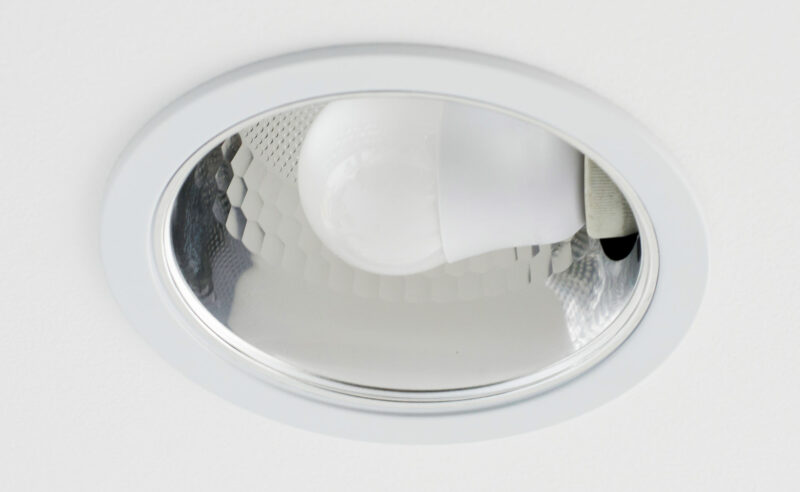
The purpose of a reflective trim is to emphasize a particular area without drawing attention to the recessed light itself. It can also be helpful in working areas like kitchen counters, serving buffets, or desks.
If you use a reflective trim to shine on art or something that you want to draw attention to, remember that the reflective surface makes the light highly visible and could even hurt your eyes if you look directly into it. You should try to hide the light behind another object, so it’s not easily observable.
10. Eyeball Trim (Adjustable Trim)
People tend to think of the eyeball trim as the first type of recessed lighting, but that’s because it’s so noticeable. We often see them in halls and the ceilings above stages since they are made to offer focused, directional light.
The eyeball trim is similar to the baffle, except that you can rotate and adjust the center of the fitting to focus the light on a particular area. They are not spotlights; their light is more diffused and less focused. But they provide excellent directional light to any location you point them at.
The eyeball trim is not intended to be invisible. It’s pretty noticeable due to its striking, eyeball-like appearance, so you should only use it where you don’t mind if the light is noticed and won’t detract from the atmosphere or aesthetics of the room. Modern eyeball trims come in different colors, so they can add a touch to a room if you use them correctly.
11. Gimbal Trim
The gimbal trim is similar to the eyeball trim in terms of functionality but not appearance. The gimbal is also adjustable to focus light in a particular direction, and you can use it as a kind of soft spotlight to emphasize an object or a specific area.
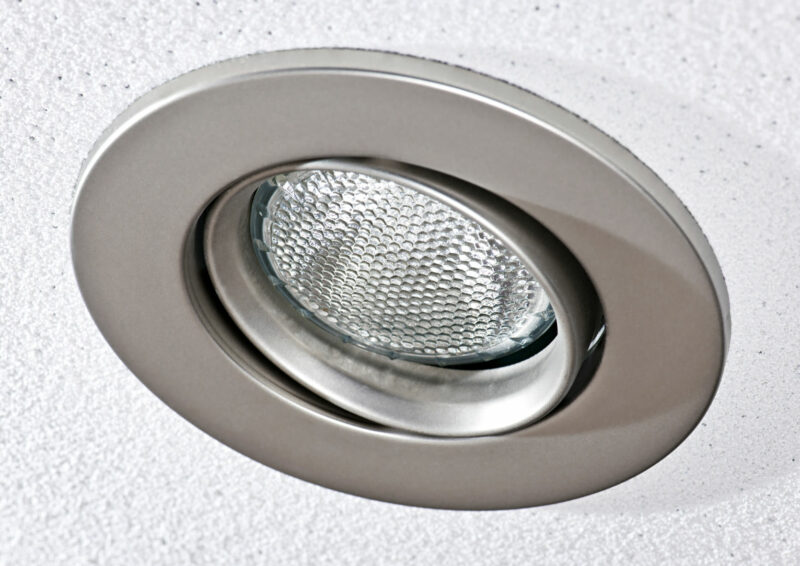
Unlike the eyeball trim, though, the light is usually flush with the edge. Where the eyeball trim has a ball sticking out of the frame, the gimbal trim doesn’t. It has a flat surface that you can tilt slightly to point the light in a different direction.
This means it’s not entirely as adjustable as the eyeball trim, so you will have to position it more carefully. But the payoff is that it’s far more subtle, stylish, and modern in appearance. That makes this type of trim closer to what most people have in mind when shopping for recessed lighting.
12. Open Trim
The open trim is similar to the baffle and reflective trims in appearance. It’s also a subtle trim that has the light bulb more or less in line with the ceiling, with a shell around it. However, this one lacks the ribbing and the reflective layer.
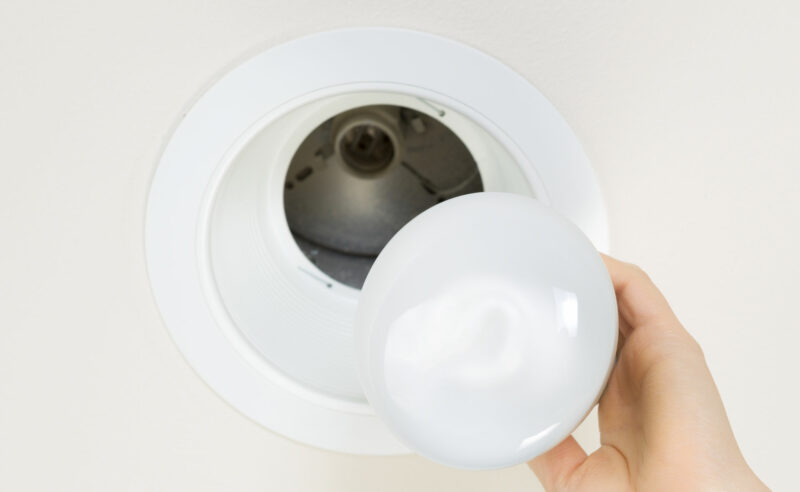
The open trim is one of the perfect trims to offer clean, bright light to a wide area. There’s nothing to soften the light or to focus it. If you want a simple trim for your recessed lighting that will do as little as possible to change or focus the light, a trim that will simply light up an area with no frills or gimmicks, the open trim is ideal.
13. Wall Wash Trim
The wall wash trim is similar to the eyeball trim and is nearly as adjustable; it’s more adjustable than the gimbal trim. However, recessed lights with a wall wash trim are far less noticeable than those with eyeball trims because their curves are far less pronounced.
The wall wash trim has a shield that partially covers the light bulb and reflects the light through an opening on one side. Recessed lights with wall wash trims are great ways to highlight particular features in a room, but they look stylish, modern, and subtle enough not to draw too much attention away from the object they’re shining on.
You can also get wall wash trims in the same colors as the wall, ceiling, or floor you place them in, which will help camouflage the lights even more.
14. Slotted Trim
If you want a type of recessed lighting that’s barely visible, a slotted trim is perfect for you. A recessed light that uses a slotted trim covers the light bulb almost entirely, except for a narrow slot on one side where the light shines through. Everything else is covered and flush with the frame, making it ideal for semi-concealed lighting.
You can adjust the light to change the location of the slot to better target the specific area you want to focus on. The slot is thick enough to allow a narrow beam of light through, which adds another option to use for highlighting or accentuating art or particular objects.
15. Pinhole Trim
The pinhole trim is another type of recessed light trim that shines a narrow, focused beam onto an object you want to accentuate, a common theme for recessed lighting.
Like slotted trims, a pinhole trim covers most of the light except for a tiny spot in the middle. This also makes it ideal to use as a specific type of spotlight. It’s popularly used to shine on architectural features, like water fountains, sculptures, or even just a particularly unique and stand-out part of a room.
Pinhole trims aren’t adjustable, though, and you must position the recessed light in just the right place to get the desired effect. They are also more noticeable than lights using the slotted trim.
16. Decorative Trims
So far, most of the trims we’ve looked at focused on partially hiding the lights. They are mostly flat against the ceiling or surface you mount them on and often come in the same colors as that surface. Decorative trims are the exact opposite.
There is a vast range of decorative trims. Most of them start from the basis of a baffle or open trim, then add features and decorations to that foundation to make the light stand out. The idea is to add character and atmosphere to a room.
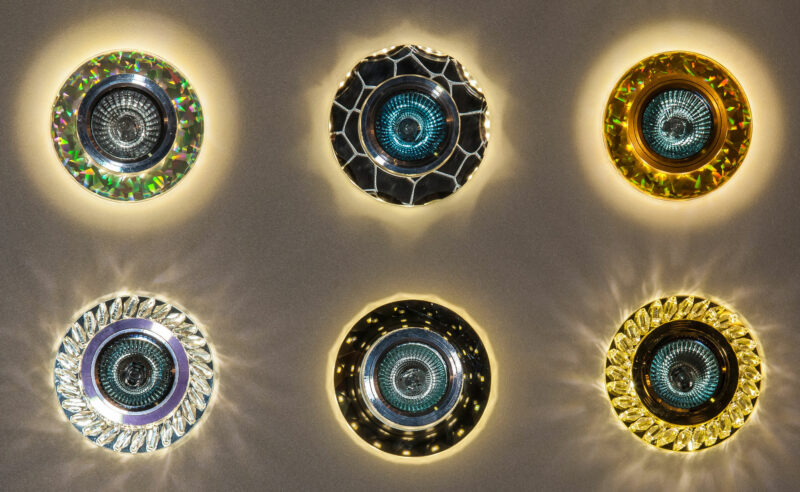
Recessed lights with decorative trims are a low-profile alternative to extravagant light fittings. Living rooms, dining rooms, or any other room that needs some style and flair but doesn’t have enough room for a pendant light or floor lamp are perfect for these recessed lights.
Some trims are simply painted in various colors to make them stand out. Others have ornaments hanging from them, like Victorian-style recessed lighting, which can be pretty extravagant.
17. Shower Trims
The name “shower trim” doesn’t necessarily mean you can only use it in a shower, though showers are a popular place to use these types of recessed lights. They are usually waterproof and resistant to the steam and humidity that often accompany areas like bathrooms.
They also often have frosted glass covers that soften the glow of the light. Different colors are also popular; for example, a reddish tint can add a romantic atmosphere to your bathroom.
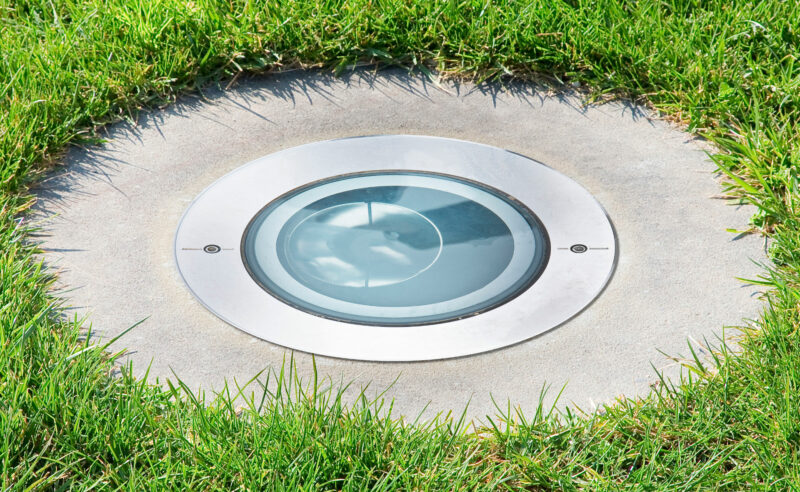
Because these recessed light trims are waterproof, people often use them in jacuzzis or inside water features like fountains. Even some swimming pools have these lights on their walls or floors to light up the pool at night. They can also be perfect for lighting up an outdoor pathway because they are waterproof.
Apart from being waterproof and often covered with frosted glass, shower trims are similar to baffle trims in almost every way.
